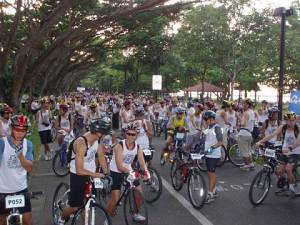Archive
Power to the People
By Nadya Huang
There is no doubt that there are many power-hungry students in the National University of Singapore. Ang Zhi Wei, a 23-year-old political science major at the university, carries his multi-plug adapter to school every day so that he can pore over his work on the laptop. Yet, he finds it difficult to even secure a seat in the library next to a power socket.
It is a common sight to see students overloading power sockets in the library with extensions and multi-plug adapters. A quick check at the university’s Central Library on a typical Wednesday afternoon will attest to that.
Although the library has over 400 power sockets available for students to use, it seems that students still find there is a shortage.
“There are really not enough power points in the Central Library,” Ang said, “You either come real early or bring a multi-plug adaptor so you can get a seat beside a power socket to do work.”
Some students also use the power sockets to charge other gadgets such as their mobile phones. These habits contribute to the Central Library’s power bill of more than $96,000 a month. The management is aware of the situation, and has taken measures to cut down power consumption in other areas to offset the high electricity bills. However, there are problems impeding these solutions.
“We try to increase the temperature of the air-conditioning in the library but certain things like books and microfilms need to be kept at a lower temperature to maintain their condition,” said Patrick Lye, principal librarian of the university’s libraries.
“We are in an old building, and the electrical infrastructure might not be able to handle it,” he said, “but we are aware of the shortages and have contacted the Office of Estate Development to find a solution.”
Students are increasingly more dependent on their mobile gadgets. They spend long hours on their laptops trying to complete their work.
While some students are less conscious about their power usage, others have been actively trying to adopt good energy habits and encouraging others to do the same.
This group of students is from NUSSU Save, a student organisation devoted to fighting climate change. In conjunction with the World Earth Hour on March 27, they organized the Earth Hour event in the university.
During the event, students folded paper lilies out of waste paper as a symbol of hope for a better tomorrow. The 2668 paper lilies collected were used to create a tree-shaped mosaic at the Sports and Recreation Centre field. The display was lighted up with light sticks as a tribute to Mother Earth. This was recorded as the largest display of paper lilies in Singapore.
At 8.30pm on the day of the event, several non-essential lights on campus were turned off. The organizers had successfully managed to convince the administration to turn off more lights this year compared to last year’s Earth Hour.
These included lights from the various faculty buildings, six halls of residences as well as facility buildings in University Hall, Yusof Ishak House and the Sports and Recreation Centre.
23-year-old Calvin Tan is the Chairperson of NUSSU Save. The second-year Life Sciences student acknowledged that Earth Hour was more of a publicity event to raise awareness.
“The event itself does not do much for the environment, but is more of a symbolic gesture directed at individuals. We did get more than 2,000 different individuals to fold paper lilies and that is 2,000 people who can help to spread the message,” said Tan.
And they are not alone in their bid to save power and cut down consumption. The university’s Office of Estate and Development and Office of Environmental Sustainability work together in several projects to reduce electrical consumption.
These projects include the replacement of conventional lamps with energy-saving lights and installation of infra-motion sensors in newly renovated toilets. The office also intends to monitor trends in excessive electrical usage on campus so that they can implement measures to prevent wastage.
With so many initiatives to cut down on energy usage, there is definitely power to the people.
City Harvest Church: New Co-owners of Suntec Singapore
By Ron Chua
City Harvest Church has paid $310 million to be the co-owner of Suntec Singapore. This purchase was disclosed by senior pastor and founder Dr. Kong Hee during the Mar. 6 service at the Singapore Expo.
Reading from a legal statement, Dr. Kong said, “City Harvest Church has acquired a substantial stake in a consortium company that owns 80 per cent of the JV (joint-venture) fund that holds Suntec Singapore.”
Dr. Kong first told his congregation six weeks before that the church had acquired a prime piece of downtown real estate land for their new building. However, he could not reveal the exact details then due to non-disclosure agreements.
City Harvest Church revealed that 25 other plots of land were considered but 19 were unsuitable and six unsuccessful. In choosing the land, Dr. Kong said that the main consideration was it had to be “able to house 12-15,000 people”, “be centrally located and easily accessible via public transport” and “have facilities for everyone”. He added that Suntec Singapore is also near its corporate office at Suntec Tower Three, and its co-office at Riverwalk.
The sum of $310 million includes rental costs, renovation costs and the cost of share acquisition in the consortium.
The Suntec Singapore International Convention and Exhibition Centre has 78 years left in its lease. As co-owners, City Harvest Church will have exclusive use of levels six and seven, where the convention hall is located. Levels four and five, which are regularly used for exhibitions and conferences, will continue to be available for public lease.
The church will carry out all its services in this new location as well as its current building at Jurong West. They will move in on Mar. 2011 when their current contract with Singapore Expo expires.
Churchgoers were excited upon this new revelation. Cindy Chung, a student from the National University of Singapore, said, “Finally we can go to church and shop and eat all in one place.”
Others were delighted with the location. 56-year-old retiree Peter Lee, who stays in Clementi, said, “This is great. Going to Suntec for service will cut my travelling time by almost half.”
Coinciding with the announcement was the launch of the Arise & Build campaign, which aims to raise $17.3 million over the next four months to fund the fifth installment in a series of 13.
Citing a confidentiality agreement, City Harvest Church could not reveal the full details of how the $310 million would be spent, nor the number and price of the shares the church had bought.
However, “all material details” have been disclosed to the Commissioner of Charities and the Urban Redevelopment Authority.
Cyclists challenge longest biking route in Singapore
By Gloria Lee
As Singapore gets set to host the Youth Olympic Games in August, cyclists here geared up for a challenging race of their own – one that holds the record as the longest round island cycling route in Singapore.
A major national event organized annually by the Nanyang Technological University Sports Club, the Bike Rally 2010 offered participants the choice of the regular 128-kilometre route or an extended 168-kilometre route for endurance cyclists.
In landlocked Singapore, the extended route was warmly welcomed by the burgeoning cycling community. In fact, registration had to be closed early due to overwhelming responses.
“This is by far the longest cycling distance offered in Singapore, and we pride ourselves on being able to offer this unique feature,” said Colin Kwek, chairperson of the organizing committee.
The organizers had to limit the number of participants due to safety and operational concerns. A total of 673 avid and leisure cyclists turned up for the event. Among the participating cyclists were two former members of the Singapore Paralympics contingent.
The Guest-of-Honour for the event was Hri Kumar Nair, member of parliament for Bishan-Toa Payoh GRC. A cycling enthusiast himself, Nair noted that cycling as a sport had recently picked up local momentum, especially since Tampines New Town opened up its footways to cyclists in December last year.
Cyclists engaged a route that started and ended at East Coast Park, with six checkpoints in between. Cyclists had to negotiate terrain in both the city and heartlands of Singapore, passing by famous landmarks such as the Esplanade and the Singapore Flyer.
Citing safety considerations and physical ability, the organizing committee determined the minimum requirement for participation to be 17 years of age. As the Bike Rally was originally organized to promote cycling as a healthy way of living, participants came from all age groups. In fact, the oldest participant was 64 years old.
A 17-year-old student from Temasek Polytechnic, Teh Jin Yu, was inspired to join the event because of the attractive lucky draw prizes that included hybrid bicycles, Nike products and Crumpler bags.
“I initially signed up because the prizes were good. But the experience turned out to be a fantastic one,” said Teh, who finished the race in eight hours.
The non-competitive race flagged off at 7:00 a.m., and the average cyclist took about seven hours to complete the race. The first cyclist came in at 1:30 p.m. while the last cyclist crossed the finishing point at 7:00 p.m.

